A new housing development is being built out of shipping containers for people experiencing homelessness on Monday, July 10, 2023 in San Diego, California. The project, known as PATH Villas El Cerrito, is being done by People Assisting the Homeless. Phase 1 will have 40 affordable rental housing units for people experiencing homelessness. (Photo Credit: Ana Ramirez/The San Diego Union-Tribune)
Like many who live near San Diego’s urban core, I witness the tragedy of people living on our streets daily. We despair at the numbers. We are losing ground. For every 10 unhoused people who find housing, 13 take their place.
Alongside other regional leaders, San Diego Foundation has spent years searching for solutions to bring more housing quickly and responsibly to those who need it most. Housing availability and affordability is the No. 1 issue crippling our economy, communities and families.
Our immediate goal is to raise millions in investment capital to build thousands of new homes through our San Diego Housing Fund. We recognize the fund will not produce new apartments and homes for several years due to the time-consuming challenges of designing, planning, permitting, constructing and finishing building development.
In the short term, what we found just south of the U.S.-Mexico border is a tested and proven solution for our housing crisis that allows construction to occur faster, safer and less expensively. In a Tijuana factory, Lego-like polystyrene building blocks, weighing 3 pounds each, are produced and shipped throughout Central America to build homes and other structures. The Central America construction process to build a concrete “post and beam” reinforced structure is simple:
- Grade the site.
- Pour a concrete foundation with steel rebar standing throughout the perimeter.
- Build a wall of interlocking blocks once the foundation has cured.
- Fill the channels with reinforced concrete.
- Continue this process until the full wall height has been reached.
- Set trusses and complete the roof to enclose the structure (the walls are very strong even without interior roof supports).
- Add wiring, plumbing and required structural element systems by utilizing empty cavities in the blocks or using a router to cut grooves in the foam blocks.
- Apply stucco to the exterior walls (like a stick-built home).
- Add stucco and paint to the interior walls.
- Add windows and hang doors.
- Furnish the spaces, and move in.
U.S. nonprofits have built medical and dental centers, community halls, worship centers, homes, and many other structures this way in Mexico, Guatemala and Honduras for more than 20 years.Using this simple technology has many benefits: earthquake and wind resistance, no assembly, concrete efficiency, multi-story engineering, subterranean and highly insulated basements, and versatility for conventional finishes like stucco, drywall and wood siding. The insulative capacities are remarkable (R23 value, exceeding wall insulation recommendations throughout the U.S.). A Nazarene retreat center in Tecate built using this system is 80 degrees indoors when it is over 100 degrees outside. The consequences of flooding due to a natural disaster are minimized when the polystyrene block is used.
Its safety is evident: at 3 pounds each, there are fewer construction work-site injuries, there is no bracing, and the material is nonflammable, reduces sound, and is resistant to bacteria, mold, pests and termites.
This building system has many efficiencies and benefits. No heavy equipment is needed. The user-friendly construction accelerates project timelines (reducing labor costs per project and allowing workers to progress quickly through several projects), causing material savings, and improved air quality. It is also non-toxic as the blocks contain no formaldehyde, fiberglass or asbestos and no chlorofluorocarbons (CFCs) are used to manufacture.
The environmental impacts are minimal. Buildings constructed this way require less heating and cooling, decreasing demand for energy production, including coal and natural gas. Resource conservation is key as timber demand is greatly decreased and building site waste is minimized. One truckload of these bricks is equivalent to seven trucks hauling concrete building blocks to the same building site greatly reducing transportation-related carbon emissions.
When technologies, processes and materials are first introduced in a system like housing production, they are slowly adopted because they are new and unknown. But aren’t these methods worth trying if we can change the trajectory of thousands of San Diego families struggling with homelessness and poverty? We need urgency and action.
The greatest benefit of this building system is the gift of time. Structures built in Central America go from poured foundation to occupied use in four weeks. While untested in the U.S., it is estimated that time to frame and insulate a structure can be slashed by 75 percent or more. That means more people housed faster and backyard ADUs producing rent revenue for homeowners more quickly.
So, what now?
According to the Regional Task Force on Homelessness, housing all Imperial Beach’s unhoused residents requires a 24-unit apartment building. Utilizing government-owned land and this construction process, a 24-plex could be built quickly and for far less than the cost of an extended-stay hotel. Doing so could help end homelessness in one of our 18 cities.
Accessory dwelling units, or ADUs, can now “pencil out” for homeowners on limited budgets. These structures provide much-needed income while housing a relative, a first responder, or someone who needs an affordable home. A true win-win for all.
Access to more low- and middle-income housing stabilizes our workforce, grows our economy, and helps attract new talent to San Diego. Building more low-income housing helps those living paycheck to paycheck from experiencing eviction and sparking a cycle of poverty and housing insecurity.
We must do everything we can to build more housing. Let’s give this proven, south-of-the-border solution a try.
This article first appeared in The San Diego Union-Tribune.




